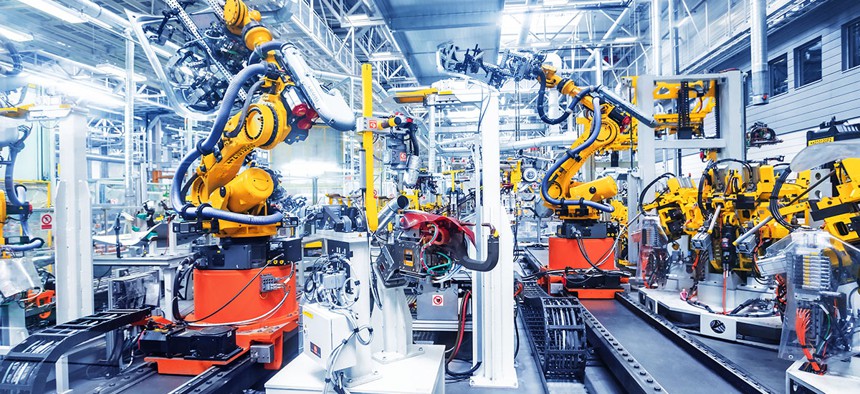Robots Used to Be Advertised As Job-Saving Technology

Nataliya Hora/Shutterstock.com
Automation is now viewed in the same manner as outsourcing.
At a U.S. trade show in 2004, Fanuc, a large supplier of industrial robots, gave a seminar on how to automate factory work. “We had very few attendees,” remembers Scott Melton, a director of sales at the company.
An explanation for his company’s empty room came when he learned another seminar—this one about outsourcing work to China—had been scheduled during the same time slot.
“That room was completely full,” he says.
It didn’t take long for a marketing idea to emerge from the interest gap. There was a need, Melton says, to educate U.S. companies that they “didn’t need to move to China to be competitive.”
And so began the “Save your factory” campaign. Thirteen years later, the website is still online.
“In a globalized economy, using robots is one of the best ways for North American manufacturing jobs to live, thrive, and survive,” it argues. “This is because robots allow companies to grow while cutting costs.”
The campaign fed into a popular selling point for automation robotics at the time.
“This was a message that U.S. automation companies had been talking about forever,” says Jeff Burnstein, the president of the Association for Advancing Automation. It had been established as early as the 1980s, when James A. Baker, a vice president of GE, quipped that “factories must automate, emigrate, or evaporate,” positioning survival as a choice between automation and outsourcing.
That choice is no longer so clear. Countries to which the U.S. typically outsources, like China, are also investing in automation as local wages rise. In 2015, according to the International Federation of Robotics, factories in China bought 68,000 industrial robots, 20 percent more than the year before, and more than all European countries combined. Large U.S. manufacturers meanwhile aren’t necessarily choosing between automation and outsourcing; most are doing both, to some degree.
“Before, it was, ‘Do I offshore or do I make it here in the U.S.? And how do I do that?’” Melton says. But as technology has advanced, industry decision-makers are “realiz[ing] it’s a global market and they have to [automate] no matter what. Everyone has to automate if they want to be competitive.”
Tom O’Reilly, the vice president of global business development at U.S.-based Rockwell Automation agrees. The focus is no longer outsourcing, he says.
“It’s more about the manufacturers being fast and maintaining competitiveness,” he says.
In turn, that’s changed the narrative about automation in the U.S. manufacturing industry. A recent McKinsey report argued the U.S.—which still hosts the second-largest manufacturing sector in the world despite losing a third of its manufacturing jobs over the past two decades—has an opportunity to gain market share in a “new kind of digital manufacturing” that uses technology such as advanced robotics, artificial intelligence, the Internet of Things, and 3-D printing.
But it offered no hope this trend would bring back jobs that have migrated overseas, or prevent those manufacturing jobs that still exist from doing so.
“It is unrealistic to expect to restore 1960s-style employment in manufacturing,” note the authors of the McKinsey report, suggesting new factory jobs would likely be in service and technology.
Economists Daron Acemoglu of MIT and Pascual Restrepo of Boston University recently estimated the adoption of robots (defined as “machines that are automatically controlled, reprogrammable and multipurpose”) in industrial settings in the U.S. has so far reduced employment and lowered wages in that sector.
Though it’s impossible to predict exactly how increasingly sophisticated automation will impact U.S. jobs in the long run, the idea it will save factory jobs from migrating overseas has never really broken into the popular narrative. During the 2016 U.S. election, Donald Trump made “bring jobs back to America” his rallying cry, and automation was discussed, like outsourcing, as a disruptive inevitability rather than an alternative.


